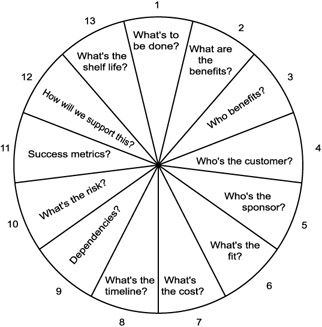1.3 The Project in Context
|
| < Day Day Up > |
|
1.3 The Project in Context
Reflecting on this and other experiences taught me to be proactive from my first day on the project, in terms of getting the whole picture and looking for signs that might foreshadow complications, if not failure. As project manager, I take it as my responsibility to anticipate, plan for, and react professionally to all discovered impediments. I believe it makes sense to prepare for that. Much of that preparation is based on assessing potential risk factors. Deploying technology is tough enough, but, for some reason, we tend to start each new project as though the environment itself will not present issues and problems, even though it always does.
The process I adopted, and have since validated many times, is a discovery process based on finding answers to the following open-ended questions. For simplicity's sake, this process will be referred to as the Big Thirteen. Do not expect to get the final answers the first time you ask each question. You may get conflicting answers. You may change your own opinions as you meet new people, gather more information, or uncover significant nuances that color known facts. The questions are listed in Exhibit 3.
Exhibit 3: Big Thirteen Interrogatory

I am no longer amazed at the wealth of information this process reveals, nor suffer embarrassment when stakeholders give me grief for my persistence, or the wonder I may express at unclear responses. Obviously, there is a little stealth embedded in this process. These questions are deliberately open-ended and politely asked even though the intent is aggressive and focused. The purpose is to:
-
Uncover hard facts
-
Assess the maturity of the project
-
Get a feel for the positions and agendas of stakeholders with whom these conversations are held
In particular, this process provides the opportunity to uncover the following:
1.3.1 Assumptions
People on projects assume a lot, much of which gets passed around and adopted as wisdom if not "the design." This can be very dangerous if assumptions are left untested. It turns out that getting people to verbalize assumptions is the best way to air them out. Errant thought processes can revolve around deliverables, dates, budgets, roles and responsibilities, or risk; in other words, everything.
1.3.2 Disconnects
This is also known as "following the bouncing ball." As you solicit and review various opinions, you might experience that somewhat odd feeling that things just are not adding up. At this point, it does not make sense to challenge anyone on these irregularities. Do, however, make note of them for future elevation and discussion as requirements, implementation strategies, and critical path elements start to congeal.
1.3.3 Issues
I listen for phrases like "We could do this, but (or 'if', or 'when')." Projects are highly dependent on time, resource, budget, and concurrent events in the business or infrastructure portions of your world. Ask enough "what if" questions, follow up with common sense, and you will uncover most if not all potential show stoppers.
1.3.4 Obstacles
The phrase "It is not going to happen" is a signal that further review of the topic is in order. This might be anything from a need for clarification all the way to a quid pro quo such as "What is it going to take to enlist your support and participation?" Other obstacles may not appear as blatant, but they are sure to come. For example, Chapter 13 studies in great detail the resistance from the end user communities you can look forward to.
1.3.5 Agendas and Personalities
Most of your team leads have control over the resource performing the actual tasks, such as router configuration, desktop computer deployment, or application code development. This is because team leads are typically managers of existing work groups with daily responsibilities in development, operations, maintenance, or support. They often feel overworked, underappreciated, and probably understaffed as well. In today's cost-conscious business culture, they may also feel under the gun to protect or justify their turf. As you listen to their views of the project, reflect on the possibility that they have personal issues or professional agendas that could temper their answers and possibly their behavior and performance as well. Knowing this about your stakeholders is always a good thing, by the way, and can be used to your advantage.
|
| < Day Day Up > |
|
EAN: 2147483647
Pages: 231